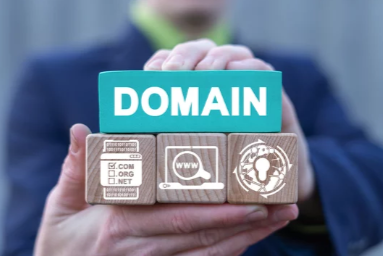Different Types Of Domains And Best Practices For SEO
Think of domains as your online home address. They’re crucial because they help people find and visit your website. Domains are like signs that guide visitors to your online space. They’re super important because they not only make your site easier to find but also helps in making it trustworthy and easy to spot on search engines like Google.
Different types of domains exist, and they each have their perks. We’ll dig into these types and share some great tips to make your website more visible and trustworthy on search engines. Let’s dive in and learn how to make your website shine brighter on the internet!
What is a Domain?
A domain is your website’s home address on the internet. It’s what people type into their browsers to visit your site. It’s made up of two parts: the name (like “google“) and the domain extension (like “.com“). For instance, “google.com” is a domain.
A domain is essentially a website’s digital address or location on the internet. It functions as a human-readable representation of the unique numerical IP (Internet Protocol) address assigned to each device connected to the Internet. This IP address enables internet-connected devices to communicate and access information across the web. Different types of domain serve various purposes and include top-level domains (TLDs), country-code top-level domains (ccTLDs), and generic top-level domains (gTLDs), among others.
Now, domains make navigating the internet far more manageable. Instead of users needing to remember lengthy strings of numbers (IP addresses) to access websites, they use domain names that are easier to recall and understand. For instance, rather than typing a sequence of numbers like “216.58.214.46” to access Google, users simply type “google.com.”
A domain consists of two main parts: the domain name and the domain extension (also known as the top-level domain or TLD). The domain name, such as “google,” identifies a specific website. Meanwhile, the domain extensions, like “.com,” “.org,” or “.net,” provide information about the type or purpose of the website, categorizing it into different types of domains.
By offering services like Google Domains, companies like Google simplify the process of obtaining a domain, making it accessible for individuals and businesses to establish their online presence with a memorable and recognizable web address.
Types of Domains:
1. Top-Level Domains (TLDs):
– Generic TLDs (gTLDs): These encompass widely recognized extensions like .com, which originally denoted commercial entities but has become universally popular. The .org extension, initially intended for organizations, signifies non-profit entities and groups dedicated to social causes. Meanwhile, .net typically represented network-related sites but is now used diversely. Other gTLDs like .info and .edu serve informational or educational purposes.
– Country Code TLDs (ccTLDs): These extensions are tied to specific countries or territories, representing their geographical origins. For instance, .us (United States), .uk (United Kingdom), .de (Germany), and .jp (Japan) signify websites associated with those countries.
2. Second-Level Domains (SLDs):
– This part of the domain name is chosen by the website owner and comes before the top-level domain. It provides the unique identity of a website, making it easier to remember and identify. For example, in YourWebsiteName.com, “YourWebsiteName” is the second-level domain.
3. Subdomains:
– Subdomains are extensions of the primary domain name. They are utilized to create separate sections or categories within a website. For instance, blog.YourWebsiteName.com creates a subdomain specifically for the blog section, allowing for better organization and navigation of content.
Understanding these distinctions in types of domains aids website owners in selecting the most appropriate domain structure to align with their branding, purpose, and target audience. Whether aiming for global recognition with a generic TLD or a country-specific focus with a ccTLD, the choice of domain type, such as generic TLDs or ccTLDs, contributes significantly to establishing an online identity and fostering user trust and engagement.
SEO Best Practices for Domains:
SEO Best Practices for Domains are essential for optimizing your website’s visibility and performance in search engine results. Here are some crucial practices to consider:
1. Choose a Relevant Domain Name:
The domain name serves as your online identity, making it crucial to select one that mirrors your business and communicates your services effectively. Different types of domain names, like “GreenGardensLandscaping.com” for a landscaping company, convey the nature of the business, instantly informing visitors about the services offered—landscaping and garden care.
Let’s break down why “GreenGardensLandscaping.com” is an exemplary choice:
- Clarity: The name is straightforward and easy to comprehend. It clearly specifies the type of service provided: landscaping for green gardens.
- Descriptiveness: It precisely describes the business niche, offering insights into what potential customers can expect.
- Relevance: The domain directly aligns with the landscaping business, making it instantly recognizable and memorable for those seeking such services.
Choosing a domain name like “GreenGardensLandscaping.com” optimizes your online presence by succinctly conveying your business focus, enhancing brand recognition, and attracting relevant traffic interested in landscaping services.
2. Select the Right Extension:
Domain extensions play a significant role in indicating the nature or purpose of a website. Extensions can signal the purpose or nature of your website. For instance, a website focusing on educational content might opt for .edu, like “MathGeniusLessons.edu,” emphasizing educational resources. Similarly, a blog about technology could use .tech, like “TechTrendsBlog.tech.” These examples showcase how different types of domains can help convey the theme or focus of a website.
- .edu Extension:
– “MathGeniusLessons.edu” is a compelling choice for an educational platform specializing in math lessons. The .edu extension is commonly associated with educational institutions, making it ideal for emphasizing educational resources, courses, or tutorials. - .tech Extension:
– “TechTrendsBlog.tech” suits a technology-focused blog or website. The .tech extension signals a focus on technology-related content, attracting tech enthusiasts and emphasizing the blog’s subject matter—tech trends, innovations, or insights. - .org Extension:
The .org extension traditionally represented organizations devoted to non-commercial and non-profit causes. For example, “GreenEarthInitiative.org” might indicate an environmental advocacy group or a platform supporting eco-friendly initiatives. It signifies a dedication to social causes, community welfare, or informational resources related to specific causes.
To know more about domain extensions read this blog – What’s the Difference Between .org vs .com vs .net?
By leveraging specific domain extensions like .edu or .tech, websites can strategically align their domain names with their content niche or target audience, enhancing visibility and immediately informing visitors about the website’s purpose or industry focus.
3. Avoid Keyword Stuffing:
While integrating keywords is valuable, avoid excessive use. For instance, “CheapAndBestCarRentals.com” might seem over-optimized. Instead, “WanderWheelsRentals.com” subtly incorporates the idea of car rentals without overwhelming the domain with keywords. Integrating keywords into a domain name can boost SEO, but it’s essential to strike a balance. Try inlcuding keywords with high search volume and try to find low competition keywords.
Consider these examples:
- Avoid Excessive Keywords:
– “CheapAndBestCarRentals.com” feels over-optimized due to excessive keyword stuffing. It might seem less natural and potentially spammy to users and search engines. - Opt for Natural Integration:
– “WanderWheelsRentals.com” elegantly integrates the concept of car rentals without overwhelming the domain with keywords. It remains descriptive and relevant without relying solely on keywords, offering a more natural and appealing name for both users and search engines.
By choosing a domain name for example “WanderWheelsRentals.com,” you maintain a balance between incorporating keywords and ensuring a user-friendly, authentic, and memorable domain name, benefiting both SEO and user experience.
4. Prioritize User-Friendly URLs:
A user-friendly URL structure benefits both users and search engines, especially when considering different types of domains. For example, “YourWebsite.com/products/shoes/men” is clear and intuitive, guiding users to specific content. Contrastingly, “YourSite.com/page1” lacks context and doesn’t convey content relevance.
Let’s further emphasize the importance of a user-friendly URL structure:
- User-Friendly URLs:
– “YourWebsite.com/products/shoes/men” provides clear navigation, guiding users directly to specific content—men’s shoes under products. This structured URL layout offers clarity, helping users understand the content hierarchy and facilitating easier navigation. - Unfavorable URL Structure:
– Conversely, “YourSite.com/page1” lacks descriptive elements, offering minimal insight into the content. Users might find it challenging to understand the page’s purpose or relevance, leading to confusion and a less intuitive browsing experience.
A user-friendly URL structure, like “YourWebsite.com/products/shoes/men,” not only aids users in finding relevant content swiftly but also assists search engines in comprehending the site’s organization and content relevance. This enhances the overall user experience and positively impacts SEO efforts.
5. Implement HTTPS Security:
– Websites using HTTPS encrypt data, ensuring secure interactions. “SafeShoppingHub.com” with HTTPS reassures customers about secure transactions, fostering trust. Users see the padlock icon in the address bar, signifying a secure connection.
Let’s expand on the significance of HTTPS for website security:
- HTTPS Encryption:
– Websites employing HTTPS encrypt data transmitted between the user’s browser and the website, ensuring secure and encrypted interactions. For instance, “SafeShoppingHub.com” using HTTPS guarantees secure transactions, safeguarding sensitive information like payment details or personal data. - User Assurance:
– When users visit a website with HTTPS, they notice a padlock icon in the address bar. This padlock symbolizes a secure connection, assuring visitors that their information is protected. It instills confidence and trust in users, encouraging them to engage with the website without concerns about data security.
By implementing HTTPS encryption, websites like “SafeShoppingHub.com” prioritize user privacy and data protection, fostering a sense of trust and reliability among visitors, ultimately contributing to a positive user experience and improved credibility, essential for all types of domain names.
6. Consistent Domain Structure:
Maintain consistency in your domain structure to aid indexing and user navigation. “MyHealthyEats.com/recipes” followed by “MyHealthyEats.com/blog” maintains coherence and helps users understand the website’s organization. Consistency in domain structure is pivotal for a seamless user experience and efficient indexing, contributing to improved domain authority. Consider this:
- Consistent Domain Structure:
– “MyHealthyEats.com/recipes” followed by “MyHealthyEats.com/blog” maintains a coherent structure. This consistency aids users in understanding the website’s organization and content hierarchy. The structured URLs clearly outline different sections of the site, such as recipes and blogs, streamlining navigation. - User-Friendly Navigation:
– Consistency in the domain structure fosters a user-friendly experience. Visitors can predict the structure of URLs, making it easier to navigate the site. For instance, “MyHealthyEats.com/recipes/chicken-soup” indicates a recipe section specifically focused on chicken soup, enhancing user navigation and comprehension.
Maintaining coherence in domain structure, with examples like “MyHealthyEats.com/recipes” and “MyHealthyEats.com/blog,” is crucial for user understanding and search engine indexing. This approach enhances user experience, organizes content presentation, and boosts SEO, making it easier for users to find relevant information based on the types of domain paths.
Wrap Up
Incorporating these practices thoughtfully and aligning them with your business objectives establishes a robust foundation for SEO success, especially when considering different types of domains. By implementing a user-friendly URL structure, choosing relevant domain names and extensions, and prioritizing secure HTTPS connections, your website enhances its visibility, credibility, and user experience in the digital realm. Consistency in domain structure aids navigation and indexing, contributing to organized content presentation. When these practices harmonize with your business goals, they not only boost SEO but also foster trust among users, ultimately positioning your website as a reliable and authoritative presence in the competitive digital landscape.
FAQs about Domains and SEO:
Q: Does domain age impact SEO ranking?
Domain age is a factor considered by search engines. Established domains may have better authority, but quality content and optimization matter more.
Q: Can changing domains affect SEO?
Domain changes can impact SEO. Proper redirection and SEO strategies during migration are crucial to maintaining rankings.
Q: Is it beneficial to have multiple domains for SEO purposes?
While multiple domains can serve specific purposes, consolidating content into one domain often enhances SEO authority and visibility.
Understanding the types of domains and implementing SEO best practices aids in establishing a robust online presence, enhancing visibility, and maximizing your website’s potential in the competitive digital landscape.





